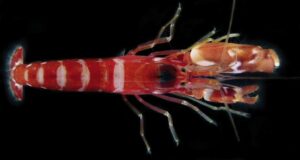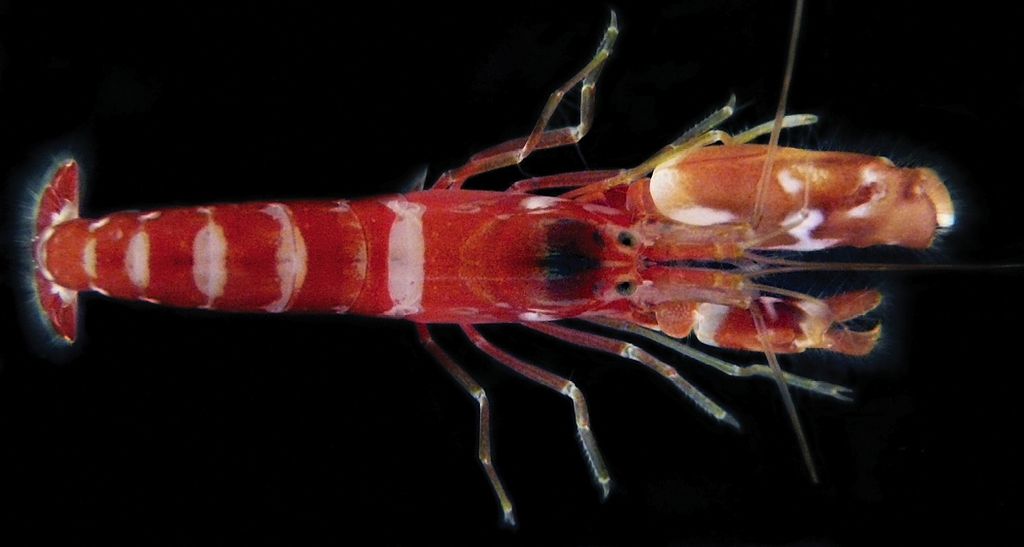
Quick care facts:
Environment: 24 – 28C (75 – 82F)
pH: 8.1 – 8.4
kH: 7 – 12
Diet: Largely Carnivorous/Omnivorous
Breeding: Difficult
General Information
Pistol shrimp (also known as alpheid shrimp or Alpheidae) is a species of shrimp approximately 3-5 cm in length recognizable by a large claw half the size of its body. Instead of pincers, this modified claw is tipped with a specialized “hammer,” which, when it snaps shut, slides into a small cavity on the lower section of the claw, creating a pressurized stream of bubbles. This stream can reach up to 12 psi at a distance of 4 cm, traveling at speeds up to 25 m/s. While the claw is typically used for hunting small fish, the pressure it creates is powerful enough to crack and even break thin glass objects.
Despite the impressive ability of its specialized claw, pistol shrimp pose more of a threat to the inhabitants of a tank rather than the tank itself, as the glass is too thick for the shrimp to damage it. They are very territorial, and if paired with other territorial or aggressive fish, a fight is practically guaranteed. Bottom-dwelling fish, snails, and most other crustaceans are also generally not recommended, as they may accidentally wander too close and trigger a defensive strike. Pistol shrimp are usually fine in a reef tank with non-aggressive species, though caution is still advised. They are a burrowing species, and can throw substrate up onto coral formations, or may cause shifting while they are digging if the base the coral is sitting on isn’t properly secure and stable. Thankfully, this usually isn’t a problem. Coral formations should be about 8 in (20 cm) from the sand bed if you are planning on adding a pistol shrimp to your reef tank. You’ll also want at least 4 in (10 cm) of substrate for the shrimp to utilize.
Tank Size
If you are planning on keeping a pistol shrimp, a 30-gallon tank is the minimum requirement, though larger tanks are better. A small tank will increase aggression, leading to problems. While pistol shrimp typically remain in their burrow keeping to themselves, they will roam occasionally in search of food and materials to support the walls of their home. Having a larger tank allows the shrimp to roam with less risk of it running into another inhabitant. Placing small rocks and shell fragments at the entrance of their burrow further reduces interactions.
Feeding Requirements
Many pistol shrimp species are scavengers, feeding on detritus and carcasses, though a few, like the Tiger Pistol Shrimp, will actively hunt small fish and invertebrates. They will also eat things such as brine and mysis shrimp, scallops, mussels, and even the flake and pellet foods you may feed your regular fish. Make sure to feed them regularly. Like with the rocks and shell fragments, placing food near the entrance to the burrow reduces travel for the shrimp, and lessens the risk to the other fish.
Breeding Pistol Shrimp
Pistol shrimp have a monogamous mating system linked to the molt cycle of the female. The female becomes sexually receptive shortly after molting and will indicate readiness to mate with chemical signals and snaps of their specialized claw. The male will then mate with and provide protection for the female while she is in this vulnerable state. Anywhere from a few hundred to several thousand eggs can be in each brood depending on the species. Eggs will usually take around four weeks to hatch after fertilization. Due to how territorial the shrimp are, this process is usually easier if they are introduced to the tank at the same time.
Diseases in Pistol Shrimp
Health issues can occur from inconsistencies in the water. Drip-acclimate the shrimp to the new water conditions before adding them to the tank to eliminate shock. Also, check and change the water regularly to keep the tank clean, and stable, and to replenish minerals that can aid the shrimp during the molting process. If you have any sick fish that need to be treated, quarantine the affected fish in a separate tank beforehand (or quarantine the shrimp, if it’s the majority of fish in the tank needing treatment). Many of the medications for fish can be harmful to the shrimp, so it’s best to isolate the patient first.
For further information, or any questions you may have, contact your local aquarium.
-William
